Click on images to enlarge
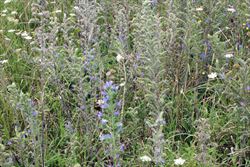
infestation (Photo: Trevor James)
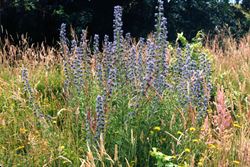
habit (Photo: Trevor James)
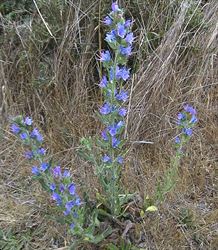
habit (Photo: Jackie Miles and Max Campbell)
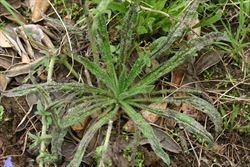
lower leaves (Photo: Trevor James)
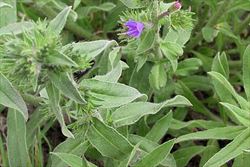
upper leaves (Photo: Jackie Miles and Max Campbell)
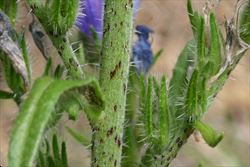
close-up of stem and immature fruit (Photo: Trevor James)
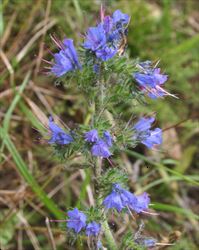
flower clusters (Photo: Trevor James)
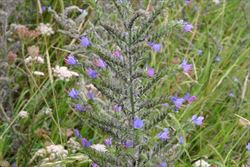
older flower clusters (Photo: Trevor James)
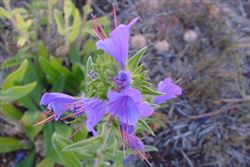
flowers (Photo: Trevor James)
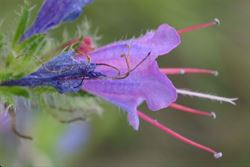
close-up of flower showing its four longer stamens and one shorter stamen (Photo: Trevor James)
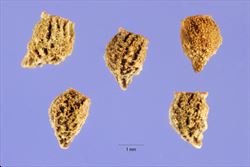
close-up of seeds (Photo: Steve Hurst at USDA PLANTS Database)
Scientific Name
Echium vulgare L.
Synonyms
Echium violaceum L. (misapplied)
Family
Boraginaceae
Common Names
blue devil, blue echium, blue thistle, blue weed, blueweed, common viper's bugloss, common vipersbugloss, viper's bugloss
Origin
This species is native to Europe (i.e. Denmark, Finland, Ireland, Norway, Sweden, UK, Austria, Belgium, Czechoslovakia, Germany, Hungary, the Netherlands, Poland, Switzerland, Belarus, Estonia, Latvia, Lithuania, western Russia, Ukraine, Albania, Bulgaria, Greece, Italy, Romania, Yugoslavia, France, Portugal and Spain), western Asia (i.e. Cyprus, Turkey, Armenia, Azerbaijan, Georgia, southern Russia, Kazakhstan, Kyrgyzstan, Tajikistan, Turkmenistan and Uzbekistan) and western China.
Cultivation
May have been cultivated as a garden ornamental in the 1800's, but is no longer deliberately cultivated in Australia.
Naturalised Distribution
The distribution of this species is largely confined to south-eastern Australia. It is naturalised in many parts of New South Wales (mostly in the sub-coastal districts of central and southern New South Wales) and Victoria, in south-eastern South Australia, in the ACT and in Tasmania.
Habitat
Mainly a weed of pastures, roadsides, waterways, gardens, disturbed sites and waste areas in the temperate regions of Australia.
Habit
An upright (i.e. erect) and relatively long-lived (i.e. biennial or perennial) herbaceous plant usually growing 30-60 cm tall, but occasionally reaching up to 1.2 m in height. It forms a basal rosette of leaves during the early stages of growth.
Distinguishing Features
- an upright and long-lived herbaceous plant initially producing a basal rosette of leaves.
- its stems are hairy or bristly and mostly unbranched.
- its elongated leaves are entire and hairy, with those along the stems being alternately arranged and stalkless.
- its blue tubular flowers (12-20 mm long) are borne along one side of a short coiled stem.
- these flowers have five stamens, four of which are significantly longer than the other and extend beyond the flower tube.
- its small woody 'seeds' are surrounded by five bristly bracts.
Seedling
Its two seed leaves (i.e. cotyledons) are rounded or oval (i.e. elliptic) in shape with rounded tips (i.e. obtuse apices). They are borne on short stalks (i.e. petioles) and are somewhat hairy (i.e. pubescent). The first true leaves are oval (i.e. elliptic) in shape with pointed tips (i.e. acute apices) and a pimply upper surface. They are covered in long hairs and have a prominent central vein (i.e. midrib).
Stems and Leaves
The upright (i.e. erect) and usually unbranched stems arise from a basal rosette of leaves. These stems are green in colour and covered in stiff hairs or bristles (i.e. they are hispid).
The rosette leaves are relatively large (1-15 cm long and up to 5 cm wide) and elongated (i.e. oblanceolate or linear) in shape. They are stalkless (i.e. sessile) or shortly stalked (i.e. petiolate), have entire margins, and usually have distinctly pimply upper surfaces. Stem (i.e. cauline) leaves are smaller, alternately arranged, stalkless (i.e. sessile) and sometimes even stem-clasping. All leaves are hairy (i.e. pubescent) on both surfaces.
Flowers and Fruit
The flowers (12-20 mm long) are blue in colour and tubular in shape. They are densely crowded along one side of a short curved or coiled stem (i.e. a boragoid inflorescence). These flowers have five petals that are fused together for most of their length (i.e. into a corolla tube) and five elongated (i.e. linear-lanceolate) sepals (5-6 mm long). They also and five stamens, four of which are significantly longer than the other, and extend beyond the flower tube (i.e. corolla tube). Flowering occurs mostly during spring and summer.
The fruit is a cluster of four 'seeds' (i.e. nutlets or mericarps) that are surrounded by five bristly bracts (i.e. the persistent sepals). The 'seeds' (2-3 mm long) are greyish-brown in colour woody, three-angled, and roughly textured (i.e. strongly wrinkled and pitted).
Reproduction and Dispersal
This species reproduces by seed. These seeds are dispersed by water, animals, wind and in dumped garden waste.
Environmental Impact
Viper's bugloss (Echium vulgare) is regarded as an environmental weed in the ACT, Victoria, New South Wales and Tasmania. It is very similar to Paterson's curse (Echium plantagineum), but is less widespread and less common. However, it invades the same sorts of natural habitats (i.e. grasslands, open woodlands and heathlands) and casues the same impacts (i.e. it can form very dense stands that compete vigorously with native groundcover plants and impede the regeneration of overstorey vegetation).
Viper's bugloss (Echium vulgare) invades conservation areas (e.g. Flagstaff Memorial Nature Reserve in Victoria and Mount Dowling Nature Reserve in southern New South Wales) and is among the weed species growing in habitats occupied by the endangered Tuggeranong lignum (Muehlenbeckia tuggeranong) in the ACT. It is also a common weed of endangered natural temperate grasslands on the southern tablelands of New South Wales and the ACT. In these grassland communities this and other weed species may be replacing or out-competing annual natives and could be affecting native species diversity.
Other Impacts
This species is a weed of crops and pastures in the temperate regions of Australia. It can sometimes also be poisonous to livestock.
Legislation
This species is declared under legislation in the following states and territories:
- ACT: C3 - a pest plant that must be contained.
- New South Wales: Class 4 - a locally controlled weed. The growth and spread of this species must be controlled according to the measures specified in a management plan published by the local control authority and the plant may not be sold, propagated or knowingly distributed (in a large number of local authority areas). See the New South Wales Department of Primary Industries Noxious Weeds List at http://www.dpi.nsw.gov.au for more detailed information on which local areas are covered in these declarations. This declaration also applies to all Echium spp.
- Tasmania: D - the importation or sale of this species is prohibited and measures to reduce its population in an area, eradicate it from an area, or restrict it to a particular area may be required.
- Victoria: C4 - a regionally controlled weed in the Wimmera, Glenelg, Goulburn and North East regions, where landholders must take all reasonable steps to control it and prevent its spread on their land and the roadsides which adjoin their land.
- Western Australia: Prohibited - on the prohibited species list and not permitted entry into the state.
Management
For information on the management of this species see the following resources:
- the Tasmanian Department of Primary Industries and Water Weed Service Sheet on this species, which is available online at http://www.dpiw.tas.gov.au.
Similar Species
Viper's bugloss (Echium vulgare) is very similar to Paterson's curse (Echium plantagineum) and relatively similar to Italian bugloss (Echium italicum). These species can be differentiated by the following differences:
- viper's bugloss (Echium vulgare) is an upright (i.e. erect) plant that has mostly unbranched stems and basal leaves that are elongated or narrow (i.e. oblanceolate or linear) in shape. Its moderately-sized (15-20 mm long) blue tubular flowers have four protruding stamens and a single smaller stamen.
- Paterson's curse (Echium plantagineum) is an upright (i.e. erect) plant that has much-branched stems and basal leaves that are oval (i.e. elliptic) or oblong in shape. Its relatively large (20-30 mm long) purple or bluish tubular flowers (rarely white or pink) have two protruding stamens and three smaller stamens.
- Italian bugloss (Echium italicum) is an upright (i.e. erect) plant that has mostly unbranched stems and basal leaves that are oval (i.e. elliptic) or elongated in shape. Its relatively small (10-12 mm long) pink, white or yellowish tubular flowers have five protruding stamens, two of which are larger than the others.
Viper's bugloss (Echium vulgare) is also somewhat similar to the heliotropes (Heliotropium spp.) and the yellow burrweeds (Amsinckia spp.). However, all of these species can easily be distinguished from Paterson's curse (Echium plantagineum) by their smaller flowers (less than 10 mm long and 3-6 mm across) which are often also white or yellow in colour.

